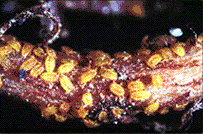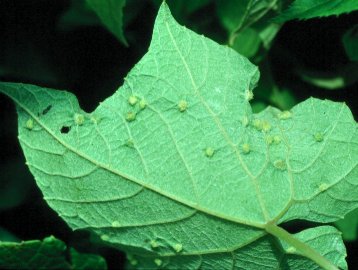The French Grape Crisis

Since the dawn of organized agriculture, humans have improved their crop plants by selectively breeding or propogating individual plants with desirable characteristics. However, it was not until the late 1800’s that this knowledge was first used to produce plants that were resistant to insect injury. The breakthrough was precipitated by the accidental introduction of grape phylloxera (Daktulosphaira vitifoliae) from North America into the wine-producing districts of France around 1860. This wingless, aphid-like insect causes the formation of galls on the roots, stems, or leaves of grapevines, and eventually kills susceptible plants.
Within 25 years of its introduction, grape phylloxera had destroyed nearly one-third (25 million acres) of the French wine grapes and threatened to annihilate the entire industry within another ten years. An American entomologist, C. V. Riley, recognized that native American grapes (Vitis labrusca) were seldom injured by phylloxera and he proposed grafting European vines (Vitis vinifera) onto American rootstocks.

C. V. Riley
In 1870, Riley began sending resistant rootstocks to J. E. Planchon in France who successfully grafted the French wine cultivars and grew them without injury in phylloxera-infested soil. Thanks to Riley and Planchon, the French wine industry was saved from certain destruction and the commercial value of resistant plant genotypes was proven beyond a doubt.

Legion of Honor Medal
In appreciation for his services, the French grape growers gave C. V. Riley a gold medal and the French government awarded him its Cross of the Legion of Honor. Ironically, the imported American rootstocks also carried incipient infections of downy mildew, a fungal pathogen that developed into another crisis for French grape growers in the early 1900’s. This saga only serves to illustrate the importance of a holistic approach to pest management.

Phylloxera galls on grape leaf

